Fig trees (Ficus spp.) are popular bird trees. Whenever the tree is figging, hordes of birds as well as monkeys and squirrels will flock there to feast on the succulent figs. One of the most documented fig species is F. benjamina, also known as Waringin or Weeping Fig LINK.
F. benjamina is an invasive species. Its roots can cause damage to nearby drains, walls, houses, etc. Because of this its presence is discouraged along roadsides and grown only in large gardens and parks. But this does not mean that they are not found along roadsides. In fact saplings are usually found growing on the branches of our roadside trees. However, as soon as they are spotted, they are removed as otherwise they will cause damage to the surrounding concreted areas and eventually kill the host trees.
Strangling figs start life on the branches of trees. A bird or any other animals that eat these figs, will pass out the tiny seeds while resting on a branch of a tree. Once the seed germinates, is will send out its roots that trail down to the ground. Once these slender roots touch the ground, they will enter the soil, drawing nutrients to support the young seedling (above left). These roots will grow in girth and in the process send out side roots that will encircle the trunk of the host tree (above right). These side roots will coalesce and thicken with time (below: Syzygium grande or Sea Apple with basket roots round its trunk along Steven Road in the 1970s). The host tree will feel the pressure of these so-called basketing roots as its trunk increases in girth until finally, many decades later, the tree will die off. This may take a century or more.
In the meantime the strangling fig will co-exist with its host, and the host tree with a large strangling fig attached to it, will exhibit dual crowns – that of the host and the fig (below: strangling fig growing on Fagraea frangran or tembusu tree in the old Bukit Timah campus of the National University of Singapore before it was chopped down in the 1980s). Once the host tree dies, and this may take up to a century or more, the fig will take over. There is no true fig trunk but a mass of coalescing basket roots that function as the stem. However, if the strangling fig is planted in the ground, a true trunk will develop.
Other common strangling figs are F. religiosa (Bodhi), F. microcarpa (Malayan Banyan) (below) and F. elastica (India-rubber Tree). The last two species can develop aerial roots from the branches. These roots increase in girth once they enters the soil to form prop roots that help support the ever-spreading branches.
Strangling figs also take roots in cracks of old building to grow and eventually cause structural damage to the walls and even building foundation (below: Old houses along New Market Road in the 1970s).
YC Wee
Singapore
January 2014


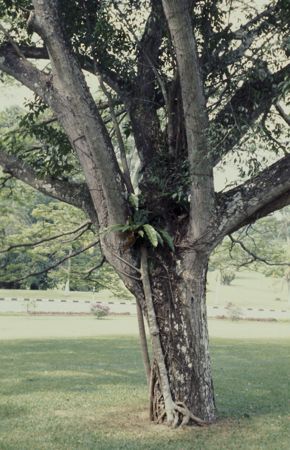
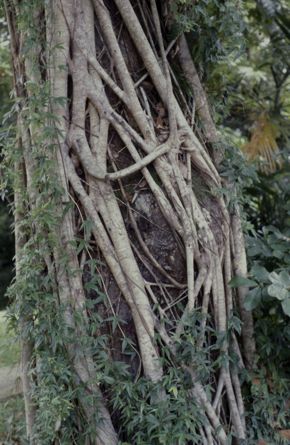
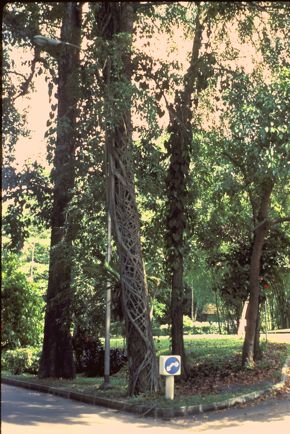
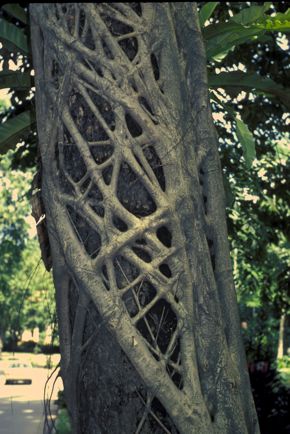
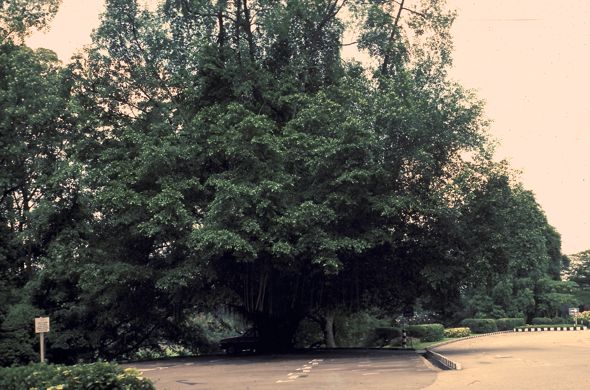
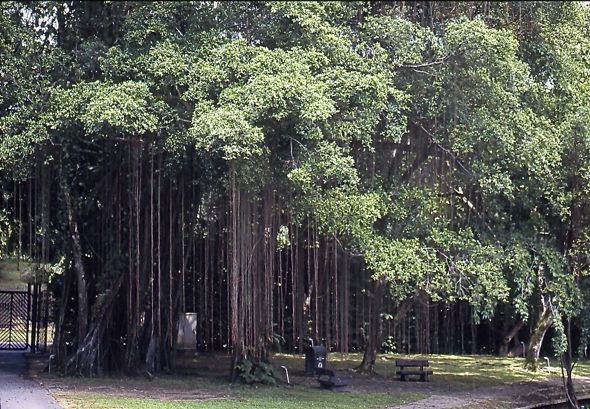








10 Responses
I remember these. I used to see lots of them growing on old shophouses as per the last photo above. I have never seen any fruit though. Are the figs edible by humans as well? Do you have any photos of strangling figs that were planted directly in the ground and developed true trunks?
Two Ficus bejamina) that grow on the ground in my condo:
http://www.flickr.com/photos/sunch28/sets/72157639881503696/
Hope they become heritage trees in time to come 🙂
Amazing. Thanks for sharing! In the 2nd photo (“Weeping Fig Roots”), is the trunk solely that of the Weeping Fig? There is no host plant inside right? I notice how incredibly invasive the roots are as well (look at the ground coverage). They could be removed if they start to cause pavements and other cemented areas to crack. 🙁
I don’t think the two fig trees in SCH’s condo will have a chance of becoming heritage trees…
Yes, it’s a pity. I wonder if there’s any compilation of S’pore heritage trees by the way? It would be nice if there were one. I am always on the lookout for grand old trees and sadly they are on the decline. Just saw a whole line of old trees chopped down last year to make way for the Downtown Line.
The Singapore Heritage Tree Register can be viewed here: http://www.nparks.gov.sg/cms/index.php?option=com_content&view=article&id=134:heritage-tree-register&catid=10:visitor-s-guide&Itemid=340 .
The criteria for registration (Heritage Tree Scheme) is just one tab away from the above page.
Yes and yes. The roots even grow upwards following the contour of the slope. Not sure if there is any damage to the townhouse on the left hand side (not shown). The tree on the 4th photo did damage the drain on the right. But then, all big trees will do similar damages.
Hi Am, good to hear from you after so many years. No pic of planted strangling figs. Normally they grow from the branches of trees. How about trying planting the seeds. Collect a ripe fig and place it in a small pot with soil. I would like to find out what happened next. Edible? Maybe!
Thanks Chong Hong!